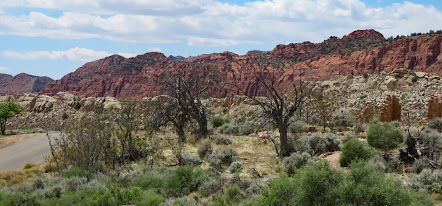Most of the buildings were sold for their lumber and stone. The only original buildings still standing are the Wells Fargo Office and a small jail. Several more have been reconstructed. The ruins of a few remain but new houses have been built just outside the park boundary.
A nice little museum is housed in the Wells Fargo Office. The Cassidy Powder House has been reconstructed and has a diorama of Silver Reef, models of the mining structures, and an audio narrative of the town’s history. A trail makes a 1/2 mile loop past the ruins. Pick up a trail guide in the museum.Wednesday, April 28, 2021
Silver Reef Museum
Sunday, April 25, 2021
Route 17 Boondocking
For being not even a mile off of the interstate, this is a surprisingly nice boondocking spot – quiet and scenic. Unfortunately, some short sighted jerk thinks this a good place to dump their trash and old furniture.
The trashed spot would be great if not for the trash because it’s large enough for several vans or RVs. We camped across the dirt road with the trash out of our line of sight. There’s also another option closer to the entry road that’s not very level but worked fine for a tent camper. Drive in at least that far to make sure you’re on BLM land. A short rocky ridge blocks interstate traffic noise. Boondock 37.27556, -113.3079Thursday, April 22, 2021
Toniquint Park
The Santa Clara River Trail runs for 2.8 miles from the South Gate Golf Course ( where it intersects with the Virgin River Trail) to Cottonwood Cove Park. This is an urban trail, passing by businesses and even following the road for a short section. The deceptively small trickle of the Santa Clara River supports a green wetland. In the spring of 2005 flooding ripped away river banks and toppled houses that had been built to close to the edge. Informative signs at Cottonwood Cove Park tell the story of the flood. The trail is accessible.
Plants that grow well in the different regions of Utah are featured in the demonstration garden which helps homeowners select the best plants for their landscaping. The paths are surfaced with small, loose gravel and are very difficult to push through. The nature center features a little pond with ducks, geese, turtles, and fish plus a network of dirt trails. The trails are hard packed. Some wheelchair users will need assistance.

We parked in the last parking lot at the end of entry road. The road loops around so exiting is easy. The parking lot at the demonstration garden looks good too. All of the spaces are short so RV must be parked across the spaces. Park 37.07949, -113.59807
Monday, April 19, 2021
Desert View Overlook & Scenic Drive
Informative signs about the Native America tribes, geology of the region, flora and fauna, and nuclear testing are located along the trail and at the two overlook areas.
The trail is short, less than 1/2 mile round trip, and completely paved. It’s ADA compliant but it goes downhill the entire way so keep the push back up in mind. Signs at the first overlook area block the view for wheelchair users. The second overlook area has breaks in the line up of signs so everyone gets a good view. All of the signs are low enough to be easily read. The overlook has several spots designated for buses and RVs. The loop road is steep but doable with any RV. Each leg of the horse shoe loop extends a few miles farther into the mountains where a ski area, a lodge, trailheads, campgrounds, and expensive vacation homes can be found. We took a quick trip along these roads but we didn’t check out the oversized parking situation. Overlook 36.33618, -115.62903Friday, April 16, 2021
Spring Mountains NRA Dispersed Camping
A round-about way involves circling the mountain range and going up the side opposite Pahrump. A paved road makes a 41 mile horseshoe loop off of US 95. The 5000’ difference in elevation means a 10 – 20 degree drop in temperature and trees instead of desert shrubbery. The scenery is spectacular but there aren’t many flat boondocking spots so arriving early in the day is a must. (unless you have friends who will save you a spot. Thanks Kathy Lee!) The boondocking spots are not good for large RVs but there are also three national forest campgrounds with first come/first serve sites and reservable sites.
The ground is soft so rolling around is a bit difficult. Boondocking 36.34157, -115.6489Wednesday, April 14, 2021
China Ranch Date Farm
The road through the canyon is washboard, steep, and has a short section that’s only one lane but it’s navigable with any RV. The parking lot is large enough for any RV. This is a Harvest Host site. We wanted to stay overnight but due to coronavirus only one RV at a time is permitted and we didn’t make a reservation early enough. Farm 35.79958, -116.19514
Monday, April 12, 2021
Boondocking near Kelbaker Road–Mojave NP
My first choice was a dud. After bouncing down a dirt road for only 1/2 mile we came to deep wash that we didn’t want risk driving through. I didn’t have a second choice, just the recollection of seeing a scattering of sites on the preserve website. So off we went to try the next dirt road and there we found a beauty of a campsite – large, scenic, tolerably level, and with plenty of evidence that it was previously used, a requirement by preserve regulations.
Scenes along Kelbaker Road from south to north. Dispersed Camping 35.24794, -115.89057

















































